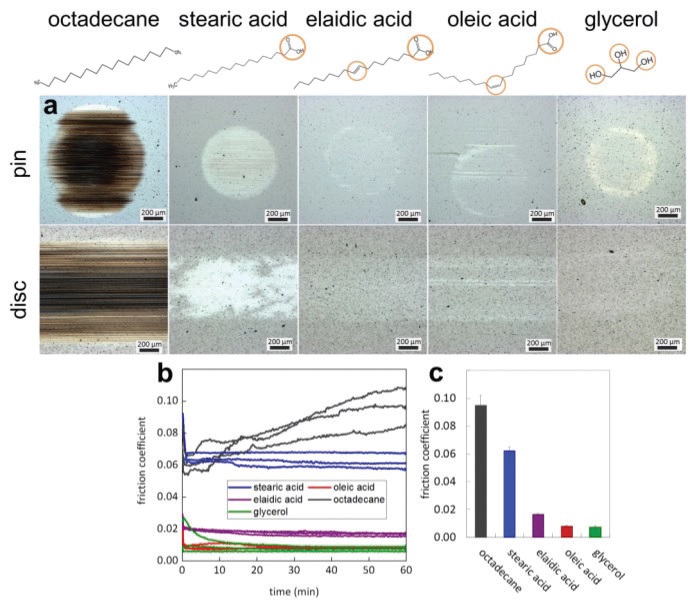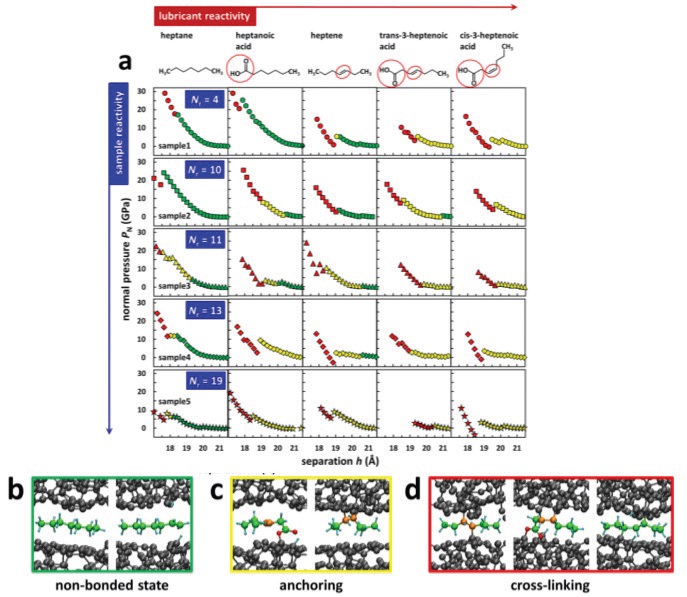Bifunctional lubricants bridge the gap
Drs. Wilfred T. Tysoe & Nicholas D. Spencer | TLT Cutting Edge February 2019
The ability of bifunctional lubricant molecules to simultaneously bind to both sliding interfaces under boundary lubrication conditions enhances their reactivity and leads to the formation of super-low friction tribofilms.
Previous articles in this series discussed how an external force can accelerate the rates of tribochemical reactions (
1, 2) but did not investigate how the force was exerted on the reactant. This issue was recently addressed by professor Michael Moseler from the University of Freiburg, Germany; his colleagues Takuya Kuwahara, Pedro Romero and Gianpietro Moras at the Fraunhofer Institute for Mechanics of Materials, Freiburg; and Stefan Makowski and Volker Weihnacht of the Fraunhofer Institute for Material and Beam Technology in Dresden, Germany. They compared the behavior of lubricants that have no reactive functional groups (octadecane) with those that have a single (stearic acid) or multiple reactive groups (elaidic acid, oleic acid and glycerol). The molecular formulae and the reactive groups are shown at the top of Figure 1.
 Figure 1. Pin-on-disc test: sliding of a ta-C pin on a ta-C disc with octadecane, stearic acid, elaidic acid, oleic acid and glycerol lubricants, where their molecular formulae are shown at the top of the figure and reactive groups are highlighted by orange circles. (a) Micrographs of the wear tracks on the pin and disc at the end of a one-hour sliding test. (b) Evolution of the friction coefficient for the different lubricants. (c) Mean friction coefficient 〈μ〉 of the last 10 minutes of the tests. (Published with permission from Ref. 3.)
Figure 1. Pin-on-disc test: sliding of a ta-C pin on a ta-C disc with octadecane, stearic acid, elaidic acid, oleic acid and glycerol lubricants, where their molecular formulae are shown at the top of the figure and reactive groups are highlighted by orange circles. (a) Micrographs of the wear tracks on the pin and disc at the end of a one-hour sliding test. (b) Evolution of the friction coefficient for the different lubricants. (c) Mean friction coefficient 〈μ〉 of the last 10 minutes of the tests. (Published with permission from Ref. 3.)
Experiments were carried out by rubbing tetrahedral amorphous carbon (ta-C) surfaces at low-contact pressures (~115-160 MPa) for one hour in a pin-on-disc reciprocating tribometer. The results, shown in Figure 1(a), reveal that octadecane has the highest wear, stearic acid moderate wear, and elaidic acid, oleic acid and glycerol show little or negligible wear. The friction (
see Figures 1(b) and (c)) correlates well with the wear behavior, ranging from high to super low.
Quantum-mechanical simulations were carried out in order to understand these effects. This is illustrated in Figure 2, which explores the influence of compressing shorter-chain versions of the experimentally tested lubricants (
shown in Figure 1) as a function of the surface reactivity, which is expressed as the number of reactive sites, N
r on the ta-C. Figure 2(a) shows the evolution of the normal pressure acting on different lubricant molecules and the effect of surface reactivity (N
r) as the two ta-C samples are pressed against each other. Symbols with different colors show whether the lubricant molecule is in a non-bonded state (in green, Figure 2(b)), in a anchoring state, i.e., the molecule is bound to one surface (in yellow, Figure 2(c)) or in a cross-linking state, i.e., the molecule is bound to both surfaces (in red, Figure 2(d)).
 Figure 2. Quantum-chemical, quasi-static pressing simulations of model lubricant molecules confined between ta-C surfaces. (a) Normal pressure PN as a function of the separation h between the outer boundaries for five ta-C samples. The Lewis structures of the model lubricant molecules are shown in the top row. The order of the five ta-C samples corresponds to the number of reactive surface atoms Nr. The color coding distinguishes three types of interfacial chemistry: non-bonded state (green, panel b), anchoring to one surface (yellow, panel c), and cross-linking of both surfaces (red, panel d). In these representative snapshots, grey spheres represent carbon atoms in ta-C. Green and orange spheres are carbon atoms of the lubricant that were initially single- and double-bonded, respectively. Oxygen and hydrogen atoms are in red and cyan, respectively. (Published with permission from Ref. 3.)
Figure 2. Quantum-chemical, quasi-static pressing simulations of model lubricant molecules confined between ta-C surfaces. (a) Normal pressure PN as a function of the separation h between the outer boundaries for five ta-C samples. The Lewis structures of the model lubricant molecules are shown in the top row. The order of the five ta-C samples corresponds to the number of reactive surface atoms Nr. The color coding distinguishes three types of interfacial chemistry: non-bonded state (green, panel b), anchoring to one surface (yellow, panel c), and cross-linking of both surfaces (red, panel d). In these representative snapshots, grey spheres represent carbon atoms in ta-C. Green and orange spheres are carbon atoms of the lubricant that were initially single- and double-bonded, respectively. Oxygen and hydrogen atoms are in red and cyan, respectively. (Published with permission from Ref. 3.)
Heptane remains in its non-bonded state unless the surface is very reactive (N
r becomes large) or the pressure is very high. Heptanoic acid and heptene are more reactive than heptane and show a tendency to form anchoring and bridging groups at moderately low pressures. However, both trans- and cis-3-heptenoic acid spontaneously anchor to the surface under low loads and quickly bridge between the two surfaces at moderate pressures. Sliding simulations reveal a similar order in reactivity, which correlates well with the experimental data (
see Figure 1).
The results demonstrate that bifunctional molecules that simultaneously bind to both sliding interfaces react rapidly due to the larger forces exerted on them during sliding. The resulting mechanochemical fragmentation leads to the formation of super-low friction tribofilms. While these simulations were performed for ta-C surfaces, the chemical reactivity also will depend on the nature of the sliding materials, thus offering the opportunity to design lubricants that bind specifically to the surfaces to tune the tribological properties.
FOR FURTHER READING
1.
Tysoe, W.T. and Spencer, N.D. (2015), “Reaction to rubbing,” TLT,
71 (8), pp. 84-86.
2.
Tysoe, W.T. and Spencer, N.D. (2016), “The shear truth about ZDDP,” TLT,
72 (10), pp. 102-104.
3.
Kuwahara, T., Romero, P.A., Makowski, S., Weihnacht, V., Moras, G. and Moseler, M. (2019), “Mechano-chemical decomposition of organic friction modifiers with multiple reactive centers induces superlubricity of ta-C”
Nature Communications, in press.
Eddy Tysoe is a distinguished professor of physical chemistry at the University of Wisconsin-Milwaukee. You can reach him at wtt@uwm.edu.
Nic Spencer is professor of surface science and technology at the ETH Zurich, Switzerland, and editor-in-chief of STLE-affiliated Tribology Letters journal. You can reach him at nspencer@ethz.ch.